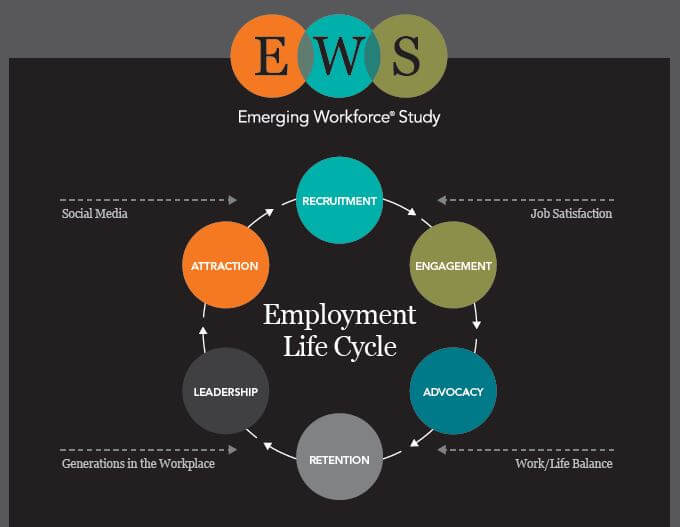I’m a sponsored blog partner with Spherion (a staffing and recruiting organization) and am participating in the release of findings from Spherion’s 2014 Emerging Workforce Study. All opinions are mine.
This is the final in a series on Spherion’s research project, the Emerging Workforce Study 2014. Over the past 15 years, Spherion has surveyed employees and human resource managers on critical workplace topics to determine the trends that shape the work environment.
Spherion created the graphic below to represent the various issues in the “employment life cycle”, which include attraction, recruitment, engagement, retention, advocacy and leadership. My first post explored the connection between employee engagement and company mission. My second post looked at the interconnection between the elements advocacy, retention and leadership. This third post explores the importance of organizational trust and employee retention.
Employee retention and leadership practices go hand-in-hand. It’s up to the senior leadership to set the tone for the company culture—bad leadership practices leads to lousy culture. Lousy cultures tend to drive away the most talented employees, who seek a more hospitable work environment.
As the year winds down and workers reflect on their New Year’s Resolutions, they may be considering leaving their current job or employer. Employers must understand their workers’ mindset to create effective retention strategies that will help keep their top talent around after the New Year. Consider these facts from the Emerging Workforce Study:
- 25 percent of all workers are likely to look for a new job in the next 12 months
- Companies report they have only put in minimal effort to retain their workers
- Companies that do not have retention programs in place have 61 percent more expected turnover in the next 12 months, compared to companies who have retention programs in place (average expected turnover 21 percent vs. 12 percent)
What can employers do reduce the departure of top talent? They can work on building trust.
Seems like a no-brainer, right? But Spherion’s research uncovered an interesting dichotomy: just because employers know that trust is important, doesn’t mean that they’re consistently following through on building trusting relationships.
Spherion asked employers to rank the items that most influenced employees’ level of engagement. Employers ranked “Employees’ level of trust in senior leadership to do what’s best for the organization and its workers” as one of the top four indicators of employee engagement. When workers were asked, “What would most improve your level of engagement?” they ranked “Gaining more of my trust in company leadership” as one of the top four responses. So, it would appear all are on the same page. Or are they?
Let’s assume that the HR managers that were interviewed were serving as proxy for their senior leadership management team, as well as providing their own opinions. What these survey results show is employers know trust is important, yet for some reason, creating trust in the workplace isn’t happening. Employees say they want to trust their company’s leadership; employers understand that it’s important. And still, a huge gap exists between these two key stakeholders in organizations.
What can leaders do to take meaningful steps to create more trust in the workplace? Here are my suggestions:
Do these five things to build a culture of trust.
Think about these areas in which you might be missing opportunities to build trust.
Ask yourself, are you demanding that people “earn” your trust, or are you giving it freely?
Many factors drive employee retention. I’ve chosen to highlight a handful based on the research from Spherion’s Emerging Workforce Study. Closing the trust gap between company leaders and employees can be the first of many strategies that employers use to retain their top talent.
What do you see as other important employee retention issues?
Want more information on the Emerging Workforce study? You can see information from past EWS studies here. You can also follow Spherion on Twitter (hashtag #EWS2014) or join them on Facebook.
Disclosure: Spherion partnered with bloggers (like yours truly) for their Emerging Workforce Study program. As part of this program, I received compensation for my time. I was free to form my own opinions about the data supplied by Spherion and all opinions are my own. Spherion’s policies align with WOMMA Ethics Code, FTC guidelines and social media engagement recommendations.

Leave a Reply